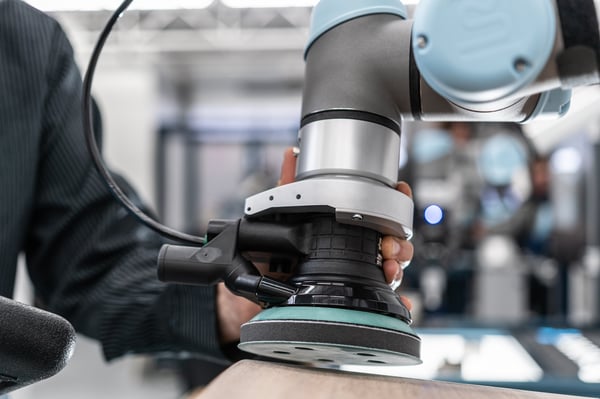Surface Finishing: The Essential Guide for Busy People

Posted on Feb 22, 2020 7:00 AM. 6 min read time
Surface finishing makes the difference between a quality product and a bargain-bin reject. This guide explains how to choose between the many options.
There are many surface finishing processes available to manufacturers. Each has its strengths, weaknesses, and peculiar quirks.
Having such a wide range of options is great. However, it doesn't make your life easy when you have to choose between the hundreds of surface finishing processes that you could use for a particular product.
We like to make life as easy as possible, so here is an essential guide to surface finishing.
What is surface finishing?
Surface finishing describes a variety of manufacturing processes which all improve the aesthetic appearance, material strength, and other properties of the finished product. They work by adding, altering, removing, or reshaping the material. These processes are usually achieved through mechanical, chemical, or electrical means.
The most well-known surface finishing processes are probably sanding and polishing. These both work by removing small amounts of the material surface with an abrasive media.
But, there are many more options for surface finishing than just sanding and polishing.
Depending on the needs of your task, you might use one process or a selection of processes to achieve the final surface finish to achieve the correct product quality.
The most well-known surface finishing processes are probably sanding and polishing.
10 common surface finishing processes
There are far too many surface finishing processes to list all of them here. But, here are a selection of some common options, many of which you are probably already familiar with:
- Sanding — Probably the most widely-known surface finishing process, sanding involves removing surface material with an abrasive sheet or disk. Some common sanding problems are now easier to solve than ever before with robotic sanding.
- Sandblasting — Abrasive beads are propelled onto the surface which removes material rapidly.
- Passivation — This improves the rust-resistance of steel by removing free iron from the surface with citric or nitric acid.
- Polishing — Polishing is similar to sanding but using a finer abrasive media. Various important factors affect the quality of polishing with robots.
- Electropolishing — A chemical polishing process rather than mechanical, electropolishing is often used on stainless steel.
- Electroplating — A process by which electricity is used to coat one metal (e.g. copper) with a thin bonded layer of another metal (e.g. gold).
- Anodizing — Another coating process by which the outer layer of iron oxide on a metal is thickened to improve the mechanical properties.
- Painting — Though not always considered a surface finishing process, painting allows you to improve the appearance and material properties.
- Dip coating — The product is dipped into a tank containing a coating material.
- Buffing — Similar to polishing, buffing is an even finer abrasive process, often performed with a soft buffing tool and an abrasive compound. Various companies use robots for buffing.
Questions to ask when choosing surface finishing
There are a huge number of options for surface finishing (with even more examples listed below).
Answering some simple questions will help you to refocus on what's important for you and make your decision easier when choosing a process.
What material and aesthetic properties does the product need? Your answer to this question will significantly reduce the number of options, which is a good thing.
Does it need to be performed manually? Many surface finishing processes require manual operation, but some (e.g. sanding, polishing, and buffing) can be performed with a robot.
Do you already carry out some surface finishing? It might not make sense to invest in a new surface finishing process if you can achieve the job with the ones you already use.
Is productivity important? If so, consider whether robotic finishing could be a good option for you.
How surface finishing works
Almost all surface finishing processes improve either the aesthetic appearance of the product and/or its mechanical or chemical properties.
Each surface finishing process achieves this in a slightly different way. However, they can be broken down into the following 4 broad categories depending on how the process works:
Adding material
Additive surface finishing processes work by adding extra material to the surface of the product.
Examples include:
- Powder coating — coating with a thin powder which sets in high temperatures.
- Galvanizing — dipping steel in molten zinc.
- Plasma spraying — surface coating which is set with a plasma jet.
Altering material
The material or chemical properties of the product's surface are altered by mechanical or chemical means.
Examples include:
- Pickling — removal of surface impurities by dipping in acid.
- Flame polishing — melting the surface with heat.
- Carburization — using heat to absorb carbon into the surface.
Removing material
Material is removed from the surface of the product either by using an abrasive media or through chemicals (usually acid).
Examples include:
- Barreling — polishing objects in a barrel of abrasive beads.
- Grinding — removing large amounts of the surface with a harsh abrasive media.
- Etching — Cutting detailed shapes into the surface with a chemical or mechanical tool.
Reshaping material
The surface of the material is deformed to change its shape, usually through the application of mechanical pressure.
- Burnishing — smoothing the fine surface texture with mechanical pressure.
- Peening — plastically deforming the surface with repeated mechanical blows.
- Knurling — deforming the material surface with a textured pattern.
Tip for Busy Manufacturers: Consider robotic surface finishing
When time is tight in a business — which it usually is — surface finishing is often one of the tasks that can take up more time than it should, particularly manual tasks like sanding and polishing.
A great option if you are looking to improve productivity is to do your sanding or polishing with a collaborative robot.
Unlike with traditional surface finishing automation, collaborative robots are quick and easy to set up and they usually have a very attractive return on investment period (often less than a year).
Not all surface finishing tasks can be automated with a robot, of course, but if you can give your finishing task to a robot, why wouldn't you!?
Could your surface finishing be done by a robot? Tell us in the comments below or join the discussion on LinkedIn, Twitter, Facebook or the DoF professional robotics community.









Leave a comment